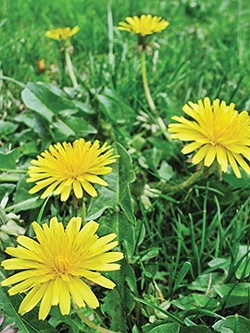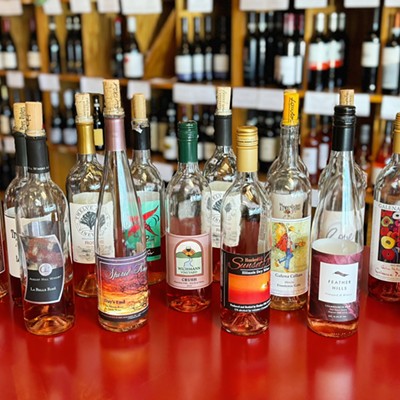“You can eat violets?” incredulous guests always ask. Yes, you can, and dandelions too, as long as they haven’t been sprayed with chemicals – or dogs’ pee.
I’ve used violets as a garnish in lots of ways – from salads, as above, to decorations for cakes. Dandelions can be eaten for their flowers and also for their greens, which are pleasantly bitter, as with arugula.
Most often, violets appeared in my mother’s famous salad. Friends invited to dinner or inviting us to a potluck asked her, “Are you going to make your salad?” I doubt they would have refused the invitation if she’d said “no,” but having been asked, she felt an obligation to comply. It was an everything-but-the-kitchen-sink affair, what used to be known as a chef’s salad: head lettuce, croutons, cut-up cheese slices, ham and/or bacon, hardboiled eggs, all sorts of chopped raw vegetables, with Good Season’s Zesty Italian dressing – and, of course, violets when in season. It was a magnificent mash-up. No matter how much she made, there was never any leftover.
Dandelion flowers weren’t used as much, although we usually had the greens in various form. But one year, my grandmother paid me to pick dandelion flowers – a penny per blossom – to make dandelion wine. It was a good way to keep a young child occupied, although I’d become totally bored by the time I’d picked enough (several quarts) for her needs. Once it had matured, she even gave me a small sip. Yuk! I don’t know what I’d think of it now, but back then it was one of the vilest things I’d ever tasted. I don’t think my grandmother liked it much, either; she never made it again.
My daughter Ashley rummages around her yard for the ingredients in this salad, which is a treat for the eye, as well as the palate. Lots of variations are possible, such as using a hot bacon dressing (and the crisp bacon bits) for a wilted salad, or other dressings, including blue cheese or even Caesar. Adding other spring vegetables such as crisp-cooked asparagus spears is another possibility.
Ashley’s spring foraged salad
For each serving:
• 1 large handful young tender dandelion greens
• 2 T.-1/4 c. chopped wild onion, ramp leaves, chives or garlic chives
• Dill and tarragon mustard vinaigrette, recipe follows
• Small handful of purple violet flowers
• 1 T. dandelion petals, approximately (with scissors, snip off and use only the yellow parts of the dandelion petals, leaving – and discarding – the lower white parts attached to the calyx)
• 1 egg
Use the smallest dandelion greens you can find. Dandelion plants that haven’t yet bloomed are best. Taste one of the leaves to make sure it’s not too bitter for your taste. (Stronger-tasting leaves work well for cooking or in a wilted salad.)
Combine the leaves with the wild onion or chives. Toss with just enough dressing to coat.
Top each serving with a poached or sunny side up egg, or you can use a sliced hardboiled egg.
Sprinkle with the violet flowers and dandelion petals. Serve immediately, especially if using a poached or sunny side up egg.
Dill tarragon mustard vinaigrette
• 1/2 c. extra-virgin olive oil
• 1/4 c. sherry vinegar, or other wine vinegar
• 1 T. Dijon or stone-ground mustard
• 2 T. each minced fresh dill and tarragon, or use all just one or the other
• 2 T. minced wild onion, ramp leaves, chives or garlic chives
• 1 T. honey, optional
• Salt and freshly ground black pepper to taste
Put all ingredients into a jar and tightly close the lid. Shake until thoroughly mixed. Refrigerate any leftover vinaigrette.
Aside from use as garnishes, violets are used to make sweet preparations, including syrups and this jelly. It has a delicately delicious floral flavor, but just as wonderful is its gorgeous pinkish purple – OK, violet – hue. For the best color, use white sugar, even if you normally use natural sugar – variously called turbinado, Demerara or sugar in the raw, which is a light brown color.
Violet jelly
• 2 c., heaping, fresh purple violet flowers (do not include stems)
• 2 c. water
• 1/4 c. fresh lemon juice, strained through a fine mesh strainer or through clean muslin or tee shirt material
• 1-1.75 oz. package pectin
• 2 c. white sugar
Rinse and drain flower petals, then place in heatproof non-reactive bowl. Glass or pottery bowls work well.
Bring water to a boil and pour over petals. Cover and allow to steep overnight, or for up to 24 hours.
Strain the liquid through a fine mesh sieve: use a wooden spoon to press all the liquid from the plant material (compost or discard the flowers when you’re through). The liquid will have a greenish tint at this point, so don’t fear that something has gone wrong. If not using it right away, the liquid can be refrigerated for up to 24 hours.
Combine the strained liquid with the lemon juice in a medium saucepan – at this point the mixture will turn pink (kids love watching this happen, and so do I for that matter!). Whisk in the pectin and the sugar.
Bring to a full rolling boil over high heat, whisking constantly until the sugar and pectin have dissolved completely.
Turn heat to medium or medium-high so that the mixture simmers vigorously. Cook, stirring occasionally, for about 5 minutes or until the mixture has reduced somewhat and thickened.
Skim off any foam and pour into jars.
To process the violet jelly for long term storage, have ready four clean, hot and sterilized 1/2 cup canning jars. Ladle the jelly evenly between them, leaving 1/8-inch head space. Wipe lids and screw on the rings, then process in a hot-water bath for 10 minutes.
Remove jars and allow to cool for 24 hours at room temperature. Makes about 2 cups (four 1/2-cup jars).
As with violet flowers, dandelion flowers are used for sweet recipes, including, in the U.K., a fairly complex Dandelion Marmalade, sometimes charmingly called “Dandelade” or “Marmalion.”
This Dandelion “Honey” hails from Poland, by way of the U.K. and is much easier and simpler to make. It does take three days. But the total cooking time is less – 1 hour and 20 minutes spread out over the three days. It’s called “honey” because the end result tastes like honey with a floral edge. Like the violet jelly, it’s heavenly on toast or a scone.
Dandelion “honey”
• 500 dandelion flowers (with scissors, snip off and use only the yellow parts of the dandelion petals, leaving – and discarding – the lower white parts attached to the calyx)
• 1 qt. water
• 2 lbs. sugar
• 1 lemon, sliced, including the peel
Day one – Add water and lemon slices to the dandelion flowers in a large saucepan or pot. Bring to a boil over medium-high heat and boil for 30 minutes. Leave the mixture in the pot at room temperature overnight.
Day two – Strain the dandelion petals from the mixture, then return the liquid to the pot. Add the sugar and place over medium-high heat, stirring until the sugar dissolves. Boil for 30 minutes and again leave the mixture in the pot overnight at room temperature.
Day three – Bring the mixture to a simmer over medium-low heat. Cook at a bare simmer for 20 minutes, then immediately put into jars. Once cooled, refrigerate for long-term storage. The “honey” is best at room temperature. Makes about 7-8 small (1/2 cup) jars.
Contact Julianne Glatz at [email protected].
Foraging spring flowers
[
{
"name": "Air - MedRect Combo - Inline Content 1",
"component": "11490391",
"insertPoint": "3",
"requiredCountToDisplay": "1",
"parentWrapperClass": "fdn-ads-inline-content-block"
},{
"name": "Air - MedRect Combo - Inline Content 2",
"component": "11490392",
"insertPoint": "7",
"requiredCountToDisplay": "5",
"parentWrapperClass": "fdn-ads-inline-content-block"
},{
"name": "Air - MedRect Combo - Inline Content 3",
"component": "11490393",
"insertPoint": "12",
"requiredCountToDisplay": "9",
"parentWrapperClass": "fdn-ads-inline-content-block"
}
]
Every year of my life, violets have appeared on our dinner table. Occasionally they show up in a vase, but far more often we use them as a garnish for salads and spring vegetables, especially asparagus.
Illinois Times has provided readers with independent journalism for almost 50 years, from news and politics to arts and culture.
Your support will help cover the costs of editorial content published each week. Without local news organizations, we would be less informed about the issues that affect our community..
Got something to say?
Send a letter to the editor and we'll publish your feedback in print!



















